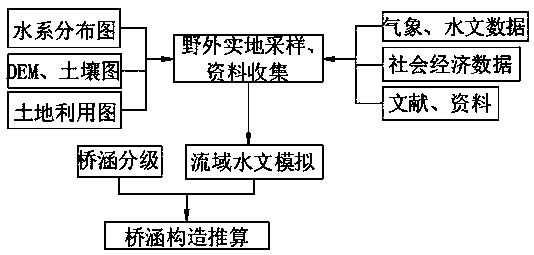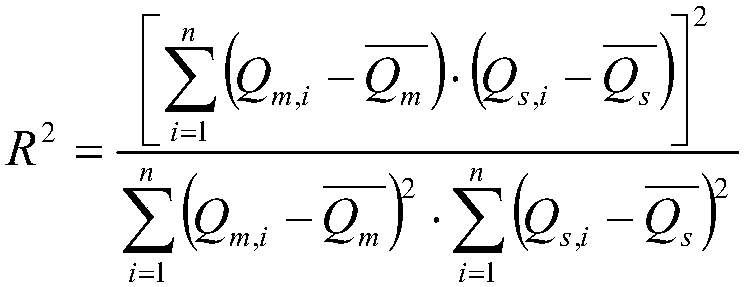A method for estimating bridge and culvert structure based on Mayi River basin
A technology for bridges and culverts and watersheds, applied in the field of bridge and culvert structure calculations, can solve problems such as unreasonable distribution of bridge and culvert construction locations, affecting the quantitative research process of cold-water fish in the Ant River Basin, etc.
- Summary
- Abstract
- Description
- Claims
- Application Information
AI Technical Summary
Problems solved by technology
Method used
Image
Examples
Embodiment 1
[0053] A bridge and culvert structure calculation method based on Ant River Basin, comprising the following steps:
[0054] S1. Collect the basic data of the Ant River Basin, consult the hydrological yearbook and literature to collect daily flow and water temperature data, and download the spatial data of the Ant River Basin from the scientific data website. The spatial data include DEM elevation data, soil data and land use data. Investigate the structural data of small tributary bridges and culverts, which include the distribution location, type, span, length, and slope of bridges and culverts;
[0055] S2. Construct the SWAT hydrological model of the small watershed and the Ant River Basin, including vector analysis of DEM elevation data, editing of soil and land use vector data attribute tables, editing index meteorological data, division of hydrological response units, and calibration and verification of SWAT hydrological models ,
[0056] The linear regression equation ...
Embodiment 2
[0093]This program first combines the collected basic data to construct the SWAT hydrological model of the Ant River Basin, uses the hydrological data to calibrate and verify the SWAT hydrological model, and obtains the daily flow data of the small watershed. The construction of the SWAT model is completed on the ArcGIS platform, which needs to input DEM elevation data, land use data, soil data, rainfall, temperature, radiation, humidity, wind speed and other data; the calibration and verification of the model use SWAT-CUP software, manual and Combining automatic calibration methods to obtain the best combination of parameters; only simulated flow data are used in this study, so the calibration of daily flow is mainly focused, and sediment and nutrients are not considered. The main steps are as follows:
[0094] Step 1: Input the DEM elevation data. The DEM elevation data adopts the SRTMDEM 90M resolution elevation data, which is jointly measured by NASA and the National Bureau...
Embodiment 3
[0118] Refer to the "Technical Standards for Highway Engineering JTGB01-2014" and "Code for Design of Highway Bridges and Culverts JTGD60-2004", and combine the SWAT model simulation to obtain the flood peak flow to calculate the bridge and culvert structure.
[0119] Step 1: Calculate the design flow of the bridge and culvert, the formula is as follows:
[0120] Q xs =M·Q x
[0121] Among them, M cycle conversion coefficient, this scheme is based on the 25-year flood, which needs to be converted into a 50-year flood, so that the known frequency is p 1 When the cycle conversion factor of 1 is 1, check the table below to get the cycle conversion factor when the specified frequency is p, which is 1.33.
[0122]
[0123] Step 2: Superimpose the road and water system layers to obtain the culvert distribution position, and determine the culvert type and culvert length through the following two tables.
[0124]
[0125]
[0126] Step 3: Calculate the span of the bridge ...
PUM
 Login to View More
Login to View More Abstract
Description
Claims
Application Information
 Login to View More
Login to View More - R&D
- Intellectual Property
- Life Sciences
- Materials
- Tech Scout
- Unparalleled Data Quality
- Higher Quality Content
- 60% Fewer Hallucinations
Browse by: Latest US Patents, China's latest patents, Technical Efficacy Thesaurus, Application Domain, Technology Topic, Popular Technical Reports.
© 2025 PatSnap. All rights reserved.Legal|Privacy policy|Modern Slavery Act Transparency Statement|Sitemap|About US| Contact US: help@patsnap.com



